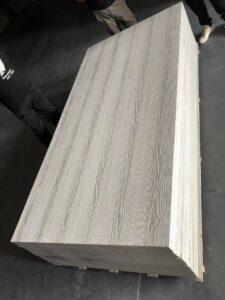 Tongue and groove (T&G) fiber cement plank is an innovative type of fiber cement siding specifically engineered to facilitate easier, quicker, and cleaner installation compared to traditional lap siding.
Tongue and groove (T&G) fiber cement plank is an innovative type of fiber cement siding specifically engineered to facilitate easier, quicker, and cleaner installation compared to traditional lap siding.
It is designed to be blind-nailed, meaning the fasteners are concealed, resulting in a smoother, more finished aesthetic without exposed nail heads.
Key Features and Benefits
- Installation Mechanism: Tongue and Groove
The core feature of this plank is its interlocking profile:
- Tongue: A continuous protrusion milled along one edge (usually the top).
- Groove: A corresponding channel milled along the opposite edge (usually the bottom).
When installed, the tongue of one plank fits tightly into the groove of the plank below it, effectively locking the boards together.
- Concealed Fasteners (Blind Nailing)
Unlike traditional siding where nails must be driven through the face of the plank (face-nailing), the T&G system allows for blind nailing:
- The nail is driven through the tongue portion of the plank.
- The groove of the next plank then completely covers and conceals the nail head.
- Benefit: This eliminates the need to fill, caulk, and paint exposed nail holes, saving significant labor time and providing a cleaner appearance.
- Aesthetics and Application
T&G fiber cement planks typically create a flush or near-flush surface when installed, offering a more contemporary, sophisticated aesthetic than the overlapping shadow lines of traditional lap siding.
- Look: It provides a continuous, panelized look, often mimicking high-end wood cladding like solid cedar or redwood paneling.
- Versatility: While often used horizontally, some T&G planks are also suitable for vertical installation to create different visual rhythms.
Comparison to Traditional Lap Siding
| Feature | Tongue & Groove (T&G) Plank | Traditional Lap Siding Plank |
| Edge Profile | Interlocking tongue and groove | Straight edge (requires overlap) |
| Fastening | Blind-nailed (concealed) | Face-nailed (visible, must be filled/painted) |
| Installation Speed | Faster, as spacing is inherent in the joint | Slower, as installers must measure precise overlap |
| Aesthetic | Flush or near-flush, seamless, modern | Overlapping shadow lines, traditional |
| Water Management | Relies on the tight fit and often a sealant | Relies on gravity and the angle of the overlap |
Tongue and groove fiber cement planks are an excellent option for projects that prioritize clean lines, fast installation, and a concealed fastening system while leveraging the inherent durability (fire-resistance, rot-resistance) of fiber cement.
NOV
2025
